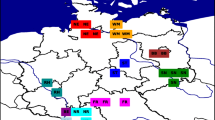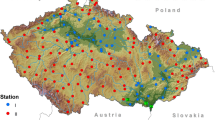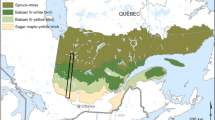Abstract
We investigated the spring frost risk over the main apple production areas in Japan under future climates using multiple sets of global circulation models and scenarios. Frost risk was judged by the daily minimum air temperature. Apple phenology was estimated with a phenology model under future meteorological conditions. Since spring cold hardiness of apple trees depends on the phenophase, we took the effect into consideration by decomposing the season into three phenophases. April temperatures are projected to increase by 0.5–2 °C for 2031–2050 and 1.5–6 °C for 2081–2100 relative to that of 1981–2000, depending on the climate models and scenarios. Spring phenology will advance by 10 days or more for the highest temperature increase case for 2081–2100. Frost risk will not monotonically change with the future temperature increase. For the scenario with the temperature increase by 1–2 °C in spring, corresponding to the medium temperature increase case among our simulation cases, frost risk will be maximized in the southern Tohoku region and central highlands, where frost risk is relatively high under the current climates. Frost risk will tend to decrease for the highest temperature increase case. During bud break to foliation, apple trees will be in highest frost risk under future climates.









Similar content being viewed by others
References
Asakura T (2011) Model Prediction of the spring phenology for ‘Fuji’ apple. Acta Horticulturae 903:1135–1140
Chmielewski F-M, Müller A, Küchler W (2005) Climate changes and frost hazard for fruit trees. Annalen der Meteorologie 41(2):488–491
Eccel E, Rea R, Caffarra A, Crisci A (2009) Risk of spring frost to apple production under future climate scenarios: The role of phonological acclimation. Int J Biometeorol 53:273–286
Food and Agriculture Organization (2019), FAOSTAT, http://www.fao.org/faostat/en/#home, Accessed May 13, 2019
Fukushima Prefecture (2019) available from https://www.pref.fukushima.lg.jp/uploaded/attachment/320791.pdf, Accessed May 29, 2019
Hoffmann H, Rath T (2013) Future bloom and blossom frost risk for Malus domestica considering climate model and impact model uncertainties. Plos One 8(10):e75033. https://doi.org/10.1371/journal.pone.0075033
Ito D (2019) Development of forecast model of bud break and blooming dates of apple cultivar ‘Fuji’ for regional analysis. Agricultural Meteorology in Tohoku 63:28–29 (in Japanese)
Kaukoranta T, Tahvonen R, Ylämäki A (2010) Climatic potential and risks for apple growing by 2040. Agric Food Sci 19:144–159
Kuryu K, Yamada T, Ichida S, Takahashi M (1977) A survey on the injury of apples caused by the late frost in Aomori, 1975. The Bulletin of the Aomori Field Crops and Horticultural Experiment Station 2:45–85 (in Japanese with English abstract)
Ministry of Agriculture, Forestry and Fisheries (2005) Crop Survey 2004, available from http://www.maff.go.jp/j/tokei/kouhyou/sakumotu/sakkyou_kazyu/index.html, Accessed May 29, 2019 (in Japanese)
Ministry of Agriculture, Forestry and Fisheries (2007) Crop Survey 2006, available from http://www.maff.go.jp/j/tokei/kouhyou/sakumotu/sakkyou_kazyu/index.html, Accessed May 29, 2019 (in Japanese)
Ministry of Agriculture, Forestry and Fisheries (2019) Crop Survey 2018, available from http://www.maff.go.jp/j/tokei/kouhyou/sakumotu/sakkyou_kazyu/index.html, Accessed Nov 27, 2019 (in Japanese)
Ministry of Agriculture, Forestry and Fisheries (2018) The 92nd statistical yearbook of Ministry of Agriculture, Forestry and Fisheries Japan, Ministry of Agriculture, Forestry and Fisheries, pp.812
Ministry of Land, Infrastructure, Transport and Tourism (1988) Land Use Fragmented Mesh Data (1987 survey), National Land Numerical Information, http://nlftp.mlit.go.jp/ksj/index.html, Accessed May 29, 2019
Sakuma N, Saito Y, Nagayama K (2013) Risk prediction models of frost damage during flower bud development for four deciduous fruit species. Hort Res (Japan) 12(4):403–409 (in Japanese with English abstract)
Seino H, Kimura S, Kishida Y (1981) An estimation of low temperature duration and high temperature duration from minimum and maximum temperatures. J. Agr. Meteorol. 37:123–126. https://doi.org/10.2480/agrmet.37.123 (in Japanese)
Sugiura T, Yokozawa M (2004) Impact of global warming on environments for apple and Satsuma mandarin production estimated from changes of the annual mean temperature. J Japan Soc Hort Sci 73(1):72–78 (in Japanese with English abstract)
Sugiura T, Kuroda H, Sugiura H (2007) Influence of the current state of global warming on fruit tree growth in Japan. Hort Res (Japan) 6(2):257–263 (In Japanese with English abstract)
Unterberger C, Brunner L, Nabernegg S, Steininger KW, Steiner AK, Stabentheiner E, Monschein S, Truhetz H (2018) Spring frost risk for regional apple production under a warmer climate. Plos One 13(7):e0200201. https://doi.org/10.1371/journal.pone.0200201
van Vuuren DP, Edmonds J, Kainuma M, Riahi K, Thomson A, Hibbard K, Hurtt GC, Kram T, Krey V, Lamarque J-F et al (2011) The representative concentration pathways: an overview. Clim Change 109:5–31. https://doi.org/10.1007/s10584-011-0148-z
Vitasse Y, Schneider L, Rixen C, Christen D, Rebetez M (2018) Increase in the risk of exposure of forest and fruit trees to spring frosts at higher elevations in Switzerland over the last four decades. Agric For Meteorol 248:60–69
Acknowledgments
The major part of this study was supported by the Regional Adaptation Consortium Project (Hokkaido-Tohoku region), directed by the Ministry of the Environment, Japan. Japan NUS Co., Ltd. (JANUS) coordinates the project for the region. Validation data for the phenology model in Supplementary material were provided from fruit-related experimental laboratories of prefectures in the Hokkaido-Tohoku region, joining the Consortium Project. 1 km gridded climate change scenarios over Japan (NARO2017) by SI-CAT (Social Implementation Program on Climate Change Adaptation Technology), directed by the Ministry of Education, Culture, Sports, Science and Technology, were used for this study. National Land Numerical Information is downloaded from the website of National Spatial Planning and Regional Policy Bureau, Ministry of Land, Infrastructure, Transport and Tourism. We acknowledge three anonymous reviewers for their comments.
Author information
Authors and Affiliations
Corresponding author
Additional information
Publisher’s note
Springer Nature remains neutral with regard to jurisdictional claims in published maps and institutional affiliations.
Electronic supplementary material
ESM 1
(PDF 2.24 mb)
Rights and permissions
About this article
Cite this article
Masaki, Y. Future risk of frost on apple trees in Japan. Climatic Change 159, 407–422 (2020). https://doi.org/10.1007/s10584-019-02610-7
Received:
Accepted:
Published:
Issue Date:
DOI: https://doi.org/10.1007/s10584-019-02610-7




